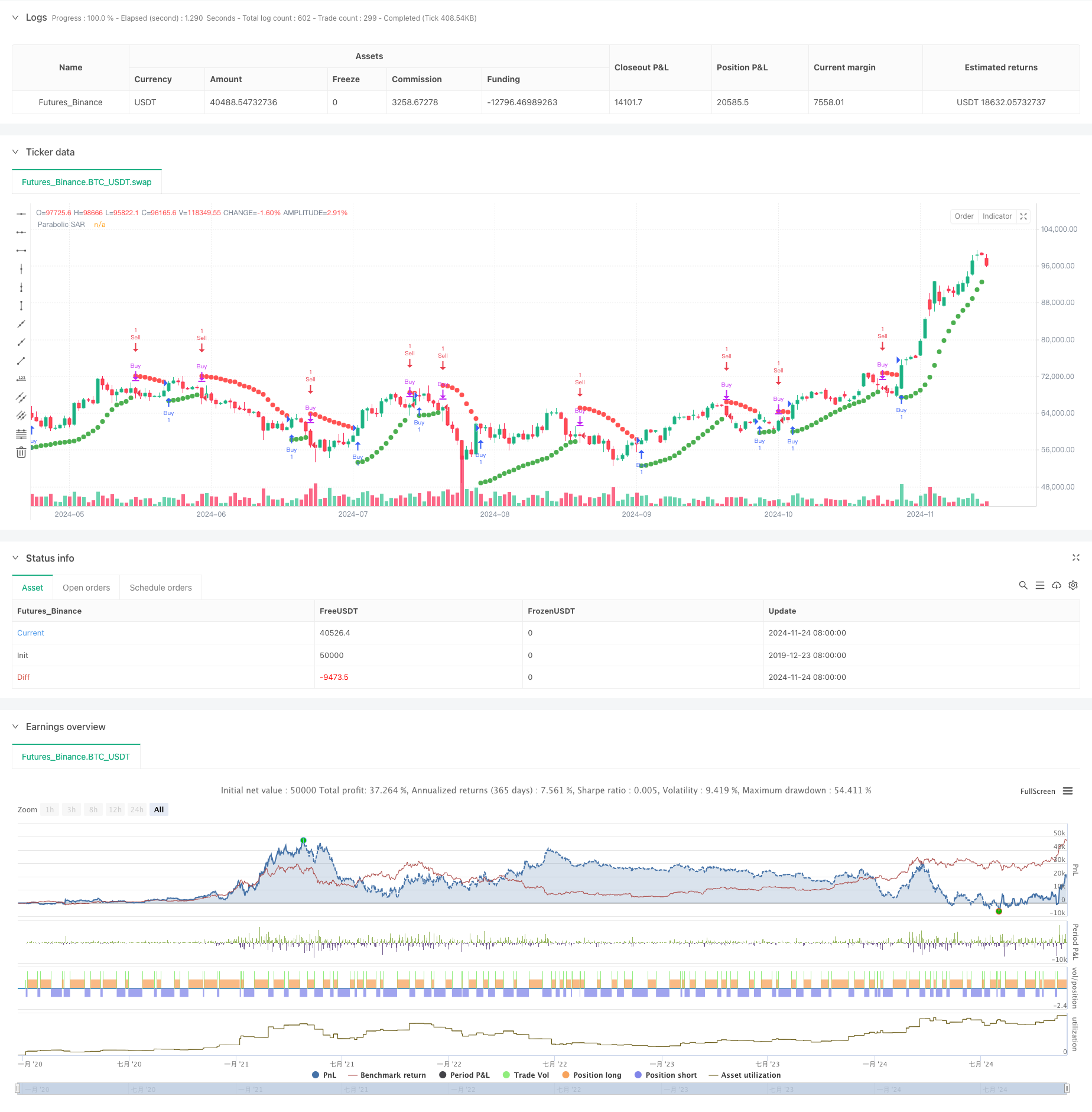Dynamic Trading Strategy System Based on Parabolic SAR Indicator
Author: ChaoZhang, Date: 2024-11-27 14:23:29Tags:

Overview
This strategy is a comprehensive trading system based on the Parabolic SAR (Stop and Reverse) indicator, making buy and sell decisions through dynamic price trend tracking. The system adopts a classical trend-following method, combining both long and short trading mechanisms to capture price movements in different market conditions. The core of the strategy lies in using SAR indicator crossovers with price to identify trend reversal points and execute position operations at appropriate times.
Strategy Principles
The strategy operates based on the following core principles:
- Uses the Parabolic SAR indicator as the primary trend determination tool, which dynamically adjusts its position according to price movements.
- When the SAR indicator crosses under the price, the system identifies the beginning of an upward trend and triggers a long signal.
- When the SAR indicator crosses over the price, the system identifies the beginning of a downward trend and triggers a short signal.
- The strategy controls the SAR indicator’s sensitivity through three key parameters: starting value (0.02), step increment (0.02), and maximum value (0.2).
- The system automatically plots SAR points on the chart, displayed in green during uptrends and red during downtrends.
Strategy Advantages
- Systematic Trend Following: The strategy is fully systematic, avoiding emotional interference from subjective judgments.
- Dynamic Stop-Loss Mechanism: The SAR indicator automatically adjusts with price movements, providing dynamic stop-loss levels.
- Bi-directional Trading: Supports both long and short positions, enabling profit potential in various market conditions.
- Visual Support: Through color-differentiated SAR points display, traders can intuitively understand market conditions.
- Adjustable Parameters: Can adapt to different market volatility characteristics through adjustment of three core parameters.
Strategy Risks
- Choppy Market Risk: May generate frequent false signals in sideways markets, leading to consecutive stops.
- Slippage Risk: In fast markets, actual execution prices may significantly deviate from signal generation prices.
- Parameter Sensitivity: Different parameter settings significantly affect strategy performance, requiring careful optimization.
- Trend Reversal Risk: May experience significant drawdowns during sudden trend reversals.
Strategy Optimization Directions
- Introduce Trend Filters: Can add additional trend determination indicators, such as moving averages, to reduce false signals.
- Optimize Parameter Adjustment Mechanism: Can dynamically adjust SAR parameters based on market volatility.
- Enhance Risk Control Module: Add fixed stop-losses and profit targets to improve risk management capabilities.
- Incorporate Volume Analysis: Combine volume indicators to improve signal reliability.
- Develop Market Environment Recognition: Add market state identification functionality to use different parameter settings under different market conditions.
Summary
This is a complete trading strategy based on classic technical indicators, characterized by systematic and objective features. Through appropriate parameter settings and strategy optimization, this system can achieve good performance in trending markets. However, users need to fully recognize the strategy’s limitations, especially its potentially suboptimal performance in choppy markets. It is recommended to conduct thorough backtesting and parameter optimization before live implementation, combined with appropriate risk management measures.
/*backtest
start: 2019-12-23 08:00:00
end: 2024-11-25 08:00:00
period: 1d
basePeriod: 1d
exchanges: [{"eid":"Futures_Binance","currency":"BTC_USDT"}]
*/
//@version=5
strategy("LTJ Strategy", overlay=true)
// Parámetros del Parabolic SAR
start = input(0.02, title="Start")
increment = input(0.02, title="Increment")
maximum = input(0.2, title="Maximum")
// Calculando el Parabolic SAR
sar = ta.sar(start, increment, maximum)
// Condiciones para entrar y salir de la posición
longCondition = ta.crossunder(sar, close) // Compra cuando el Parabolic SAR cruza por debajo del precio de cierre
exitLongCondition = ta.crossover(sar, close) // Venta cuando el Parabolic SAR cruza por encima del precio de cierre
// Condiciones para entrar y salir de la posición
shortCondition = ta.crossover(sar, close) // Compra cuando el Parabolic SAR cruza por debajo del precio de cierre
exitShortCondition = ta.crossunder(sar, close) // Venta cuando el Parabolic SAR cruza por encima del precio de cierre
// Ejecutando las órdenes según las condiciones
if (longCondition)
strategy.entry("Buy", strategy.long)
if (exitLongCondition)
strategy.close("Buy")
// Ejecutar las órdenes de venta en corto
if (shortCondition)
strategy.entry("Sell", strategy.short)
if (exitShortCondition)
strategy.close("Sell")
// Opcional: Dibujar el Parabolic SAR en el gráfico para visualización
// Si el SAR está por debajo del precio, lo pintamos de verde; si está por encima, de rojo
colorSar = sar < close ? color.green : color.red
plot(sar, style=plot.style_circles, color=colorSar, linewidth=2, title="Parabolic SAR")
- Multi-Period Moving Average Crossover with Volume Analysis System
- Dual Moving Average Momentum Tracking Quantitative Strategy
- Dual Moving Average Crossover Strategy with Adaptive Stop-Loss and Take-Profit
- Adaptive Trend Following Strategy Based on Momentum Oscillator
- PVT-EMA Trend Crossover Volume-Price Strategy
- MACD-EMA Multi-Period Dynamic Crossover Quantitative Trading System
- MACD Dynamic Oscillation Cross-Prediction Strategy
- VWAP-ATR Dynamic Price Action Trading System
- Dynamic Trend Quantitative Strategy Based on Bollinger Bands and RSI Cross
- Mean Reversion Strategy with Bollinger Bands, RSI and ATR-Based Dynamic Stop-Loss System
- Adaptive Volatility and Momentum Quantitative Trading System (AVMQTS)
- Advanced Trend Trading Strategy Based on Bollinger Bands and Candlestick Patterns
- ATR Volatility and Moving Average Based Adaptive Trend Following Exit Strategy
- Dual EMA Momentum Trend Trading Strategy with Full Body Candle Signal System
- Dual Timeframe Supertrend with RSI Optimization System
- Dual Moving Average Crossover Trend Following Strategy with Dynamic Stop-Loss and Take-Profit System
- Multi-Timeframe Trend Following Trading System with ATR and MACD Integration
- Dual Timeframe Supertrend RSI Intelligent Trading Strategy
- Dual MACD Price Action Breakout Trailing Strategy
- Multi-EMA Trend Momentum Recognition and Stop-Loss Trading System